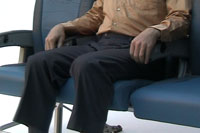American Ergonomics Corporation
Innovative Seat Technology for Comfort and Safety

CBM Seat for Aircraft Seat Prototype

Range of Motion

Passive adjustment

Push down to stop CBM

Pull up to release CBM

Retrofitted CBM Front

Retrofitted CBM Back
The Counter Balanced Motion (CBM) Seat is a dynamic mechanism that provides passive, automatic adjustment of the seat, backrest and headrest. The CBM is designed to provide comfort by supporting the motion of the seated passenger. This system is user activated without motors.
US Patent no. 5,244,252; 5,460,427; 5,558,399; 5,735,574; Patent pendings 10/836964. Japan Patent No., 3-518615; Hong Kong Patent, 1012313B.
CBM Seat Dynamics and Ergonomic Function
The present CBM prototype is installed in two standard production economy class triple seat frames. These seats were modified to have the CBM arcuate reclining features as follows:- Take off & landing position with upright backrest and torso angle at 16', and seat at 9' to 17'.
- Torso is reclined 37' with thigh to torso angle of 134' to help the legs and spine extend.
- Mid-range of motion, backrest reclined at 105' and seat at 17' to 20', torso reclined 29'.
- Reclined Backrest with the seat at 27' and the torso reclined 31' for sleeping during flights.
- Upright backrest, seat at 9', torso angle 16' and torso to thigh angle of 113' with legs extended.
Mechanism Range Of Motion Specifications
- Seat cushion tilt range: 18'
- Angle of seat cushion top plane to horizontal plane: 9 - 27'
- Back Recline controlled by standard push button: 20'
- Adjustment for the standard recline mechanism: 95 ' 115'
- Headrest ROM Vertical: 8in, Horizontal: 6.3in
- Backrest recline range of motion provided only: 95-103'
- by the CBM (with standard back frame set upright): 8'
- Total Backrest recline combined. CBM + standard: 122'
- Responsive action of the CBM Seat movement: Instantaneous
- Return spring force to return seat/back upwards: 10lbs
- Weight (per set of triplet): 112lbs
CBM Seat Dynamic Properties
- The CBM seat mechanism provides arcuate seat motion that glides the seat pan forward and increases backrest recline angle within the same envelope.
- The CBM seat automatically facilitates and supports body alignment and voluntary movement. It provides a stable, restful reclining posture to improve comfort during flights.
- The CBM seat provides comfort by passive adjustment. With the CBM Seat's automatic, arcuate adjustment, the occupant can shift from upright to reclined positions by body motion.
- A break release thumb switch controls the CBM seat and backrest motion. Push up to release ' the CBM seat's arcuate motion is free. Push down to engage the friction brake - the seat position is held.
- The CBM seat reduces head trajectory.
- The CBM seat mechanism acts as a seat suspension or shock absorber during some vertical and horizontal acceleration caused by turbulence or hard landing.
- The CBM seat's automatic posture adjustment in conjunction with the standard seat recline, offers more seating comfort to the occupant.
Standard Seat Features
The CBM seat and backrest structure supports the occupant's body while the standard back frame is used primarily for compartment definition and accessory support (i.e. monitor or phone ).- Tray table
- Armrest
- Seat belt attachment hardware
- Under seat leg room and luggage stowage
Design Optimization
The CBM has the potential of becoming the next generation of aircraft main cabin seating. This prototype was confined to retrofitting existing triplet frames. By designing the entire frame based on the CBM, the design can be optimized for comfort, space, weight and cost.US Patent no. 5,244,252; 5,460,427; 5,558,399; 5,735,574; Patent pendings 10/836964. Japan Patent No., 3-518615; Hong Kong Patent, 1012313B.